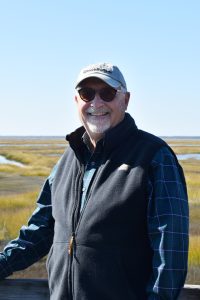by Ray Burke, Institute Supporter
 Raising a family of marsh wanderers meant that my parents, like so many others, were used to welcoming home wet, muddy children with their similarly afflicted pets.
Raising a family of marsh wanderers meant that my parents, like so many others, were used to welcoming home wet, muddy children with their similarly afflicted pets.
On one particular day in August 1965, however, there was a significant departure from the normal pattern of wet and muddy.
On that day, everybody was wet and muddy… and oily. Tar balls had migrated from the Stone Harbor and Avalon beaches inland to the beach waters of Jenkins Sound. I had encountered tar balls on the beach all summer, and every beach dwelling had a bucket of kerosene soaked rags at the front door to clean off tar from feet and legs. It was a situation almost unimaginable today but considered just an annoyance at the time.
I had been noticing that the waterline and mooring lines on my old wooden rowboat at Shell Bay were oily as well at low tide and could see that the marsh grasses were trapping oil, and even the family oyster bed at the mouth of Gravely Run Stream was involved.
I remember asking my Dad where all this oil was coming from. His theory was that some of the dozens of ships sunk off the beaches by German U-Boats (1942-43) were breaking up and releasing the oil trapped in their holds. He commented that during World War II people would stand on the beach after dark and watch burning offshore. The “Battle for the Atlantic” had come to America. At twelve years old, this was my first real encounter with mass environmental degradation.
The oily summer of 1965 has left a lasting impression on me and created a lifetime of awareness that the coastal environment I love is vulnerable to human activity.
Today that concern is even greater, but I know that there is hope because the Institute is not sitting idly by. Instead, they are finding innovative solutions to combat today’s greatest threats.
